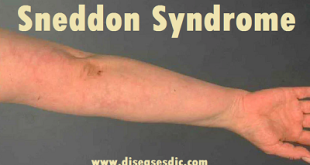Overview
Cold agglutinin disease is a form of autoimmune hemolytic anemia caused by cold-reacting autoantibodies (a type of protein produced by the immune system). Primary cold agglutinin disease is usually associated with monoclonal (produced from a single ancestral cell by repeated cellular replication) cold-reacting autoantibodies. Primary cold agglutinin disease is chronic and occurs after the fifth decade of life, with a peak incidence in the seventh and eighth decades. Secondary cold agglutinin disease is predominantly caused by infection and lymphoproliferative disorders in which lymphocytes (white blood cells) are produced in excessive quantities. It is essential with chronic cold agglutinin disease to keep all body parts warm at all times and avoid cooling of body parts. Appropriate clothing is necessary for cold environments, and avoidance of cold foods and working in cold storage areas is also important.
Cold agglutinin disease is a rare type of autoimmune hemolytic anemia in which the body’s immune system mistakenly attacks and destroys its own red blood cells. When affected people’s blood is exposed to cold temperatures (32º to 50º F), certain proteins that normally attack bacteria (IgM antibodies) attach themselves to red blood cells and bind them together into clumps (agglutination). This eventually causes red blood cells to be prematurely destroyed (hemolysis) leading to anemia and other associated signs and symptoms. Cold agglutinin disease can be primary (unknown cause) or secondary, due to an underlying condition such as an infection, another autoimmune disease, or certain cancers. Treatment depends on many factors including the severity of the condition, the signs and symptoms present in each person, and the underlying cause. Symptoms of cold agglutinin disease (CAD) are often triggered or made worse by cold temperatures or a viral infection. Therefore, symptoms generally are worse during winter months. Symptoms may arise suddenly or gradually.
Cold Agglutinin Disease in hand and leg
Types
There are three major types of cold-sensitive antibodies that can cause clinical manifestations: cold agglutinins (which cause CAD), Donath-Landsteiner antibodies (which cause paroxysmal cold hemoglobinuria [PCH]), and cryoglobulins (which cause a vasculitic picture):
Cold agglutinins – Cold agglutinins are antibodies that recognize antigens on red blood cells (RBCs) at temperatures below normal core body temperature. They can cause agglutination of the RBCs and extravascular hemolysis, resulting in anemia, typically without hemoglobinuria.
Cold agglutinins may be seen with the primary cold agglutinin disease (CAD) or secondary cold agglutinin syndrome (CAS). The antibodies are typically immunoglobulin M (IgM) and the antigen is typically “I” or “i” on the RBC surface.
- Primary CAD– Primary CAD (also called idiopathic CAD) is used to refer to cold agglutinins that cause RBC agglutination and extravascular hemolysis in the absence of an underlying disorder. As discussed below, these individuals are thought to have a low-grade clonal bone marrow disorder.
- Secondary CAS– When cold agglutinins arise in the setting of an underlying disorder such as a viral infection, autoimmune disorder, or lymphoid malignancy, the syndrome is referred to as secondary CAS.
Donath-Landsteiner antibodies – Donath-Landsteiner antibodies are antibodies that recognize RBC antigens at cold temperatures, but unlike cold agglutinins, these antibodies fix complement and cause hemolysis in the circulation (intravascular hemolysis). This is why patients have symptoms associated with hemoglobinemia and hemoglobinuria (eg, flank pain, dark urine). This condition is called paroxysmal cold hemoglobinuria (PCH). The antibodies are usually IgG and they are often directed against the “P” antigen on RBCs.
Cryoglobulins – Cryoglobulins are antibodies that form immune complexes in the cold; they generally do not interact with RBCs. Cryoglobulins can cause a systemic vasculitis, a systemic inflammatory syndrome, or vascular occlusion.
Epidemiology
The development of cold agglutinin syndrome is relatively uncommon, at least in the classic chronic form. Various reports state that 7-25% of cases of autoimmune hemolytic anemia are cold agglutinin mediated. Thus, while the incidence of cold and warm autoimmune hemolytic anemia (combined) is approximately 1 in 80,000, the incidence of cold agglutinin disease is approximately 1 in 300,000. Among autoimmune hemolytic anemias, cold agglutinin disease is the second most common cause, after warm autoantibody–induced immune hemolysis.
What is the mechanism leading to cold agglutinin?
In cold agglutinin disease, the antibodies attack healthy red blood cells when exposed to cold temperatures, about below 50 degrees. Blood in your fingers, toes, nose, and ears can quickly drop below normal body temperature.
Cold agglutinins attach themselves to red blood cells and pull them together, attracting other proteins (antibodies) in your immune system to break down cell walls and destroy cells. The red blood cells are then destroyed. Then your body may not be able to make enough new red blood cells to replace the damaged ones, resulting in anemia. In this case your blood is not enough to carry oxygen to your vital organs to function as they should.
Mechanism of CAD
Causes of Cold Agglutinin Disease
Most of the time, cold agglutinin disease happens by itself, without any other related health problem. Doctors call that the primary, or idiopathic, form of the condition, and they don’t know why it happens.
In other cases, another illness can bring on cold agglutinin disease. One of the most common conditions that triggers it is lymphoma, especially in people over 60. That’s a type of cancer that affects your lymph nodes. But it also can happen if you have:
- A bacterial infection like E. coli, syphilis, or Legionnaire’s disease
- A virus, like the ones that cause the flu, hepatitis C, or AIDS
- A parasitic infection like malaria
- Other conditions that cause your immune system to turn on your body
- Other kinds of cancer that affect your blood cells, like multiple myeloma or leukemia
Cold Agglutinin Disease Symptoms
Symptoms of CAD tend to be the result of anemia (inadequate red blood cells) or problems with blood circulation. It’s also possible to experience no symptoms, especially if your anemia develops gradually.
You may develop any of the following symptoms due to CAD:
- Fatigue
- Weakness
- Dizziness
- Unusually pale skin (pallor)
- Shortness of breath
- Fast heart rate
- Cold fingers or toes
- Painful and reddish or bluish skin on or next to hands and feet (Raynaud phenomenon)
Red blood cell destruction can also lead to a buildup of a substance called bilirubin, leading to symptoms of jaundice:
- Dark urine
- Yellowish skin or eyes
If your red blood cells are destroyed quickly, you may experience the following severe symptoms of CAD:
- Chest pain
- Decreased alertness
- Confusion
- Temporary loss of consciousness
- Unstable heart rate and blood pressure
In certain severe cases of blood circulation problems in CAD, ulcers (open sores) may develop on your finger or toes.
While it’s possible that CAD might increase the risk of developing blood clots, there isn’t enough data to confirm this connection.
Patient’s toe develops acrocyanosis as a result of cold agglutinin hemolytic anaemia.
Risk factors
- In severe cases, ulcers may develop on the extremities of digits.
- There is a possibility that people living with CAD are at a higher risk of developing blood clots, although more studies are needed to clarify this potential association.
- CAD can be a long-standing (chronic) disease, but can be self-limited and clinically silent, especially when associated with infectious diseases; although it can be caused by severe diseases, CAD itself does not seem to be associated with a significantly decreased life expectancy.
Complications
All complications are rare but include:
- Haemolytic crisis following cold exposure or cardiopulmonary bypass.
- Ischaemic necrosis of extremities following prolonged cold exposure.
- Severe symptomatic anaemia.
- Development of malignant disease in a patient initially thought to have a primary form.
Diagnosis
Your healthcare provider will review your medical history and symptoms. They’ll run blood tests to determine whether you have hemolytic anemia and the autoantibodies associated with CAD.
Blood tests for diagnosing hemolytic anemia include:
- A complete blood count (CBC): A CBC provides detailed information about your red blood cells that can be used to diagnose hemolytic anemia. It shows how many red blood cells you have, their size and your hemoglobin level. Hemoglobin is an important protein that allows your red blood cells to transport oxygen.
- A reticulocyte count: A reticulocyte count measures how many immature red blood cells (reticulocytes) you have. Your body may produce a higher-than-normal amount of reticulocytes if your immune system destroys mature red blood cells.
- Serum levels tests: High levels of lactate dehydrogenase (LDH) and bilirubin and low levels of haptoglobin are signs of hemolytic anemia.
Your healthcare provider will check for the autoantibody that attacks your red blood cells to determine if your hemolytic anemia is CAD. Tests include:
- Direct Coombs test (DAT): The Coombs test checks for autoantibodies associated with CAD. During the test, your red blood cells are separated from the other parts of your blood and placed in a controlled environment. A special solution is added. If the cells clump together (agglutinate) with the solution, the test is positive for the autoantibody.
- Cold agglutinin titer test: This test checks how concentrated the autoantibodies are, or how many of them you have. A high concentration of autoantibodies is a sign of CAD.
Once your healthcare provider confirms your diagnosis, they’ll explore whether your CAD is related to an underlying condition (secondary cold agglutinin disease).
What is the treatment for Cold Agglutinin Disease?
Cold agglutinin disease (CAD) patients whose disease symptoms are not severe, drug therapy is not required, and CAD can be resolved by avoiding exposure to cold, keeping warm, or moving to a warmer climate.
Medicines for treating cold agglutinin disease
In more severe CAD cases, monotherapy with Rituximab, an antibody that selectively binds to and induces the destruction of immune cells called B-cells that produce the autoantibodies, can be used. This is effective in about 60% of cases. The response is generally observed within one to two months of treatment, and the effect of the treatment can last one to two years. However, Rituximab is now recommended as the first-line treatment of CAD.
Combined treatment with rituximab and fludarabine results in higher response rates (76% of cases) and longer periods of remissions (on average, 6.5 years). However, the combined treatment can have serious side effects. That is why it is recommended only when rituximab has not worked alone.
Rituximab combined with oral Cytoxan (cyclophosphamide), prednisone or other immunosuppressive medications may be used for cases of CAD that do not resolve with other treatments.
Other treatments include:
Plasma exchange or plasmapheresis may be performed to remove the IgM or cold agglutinin antibodies from the blood to reduce or alleviate disease symptoms. However, the effect of plasmapheresis is temporary because the B-cells that generate these antibodies are not removed by this procedure. It is useful to overcome acute hemolytic crisis and before surgery-requiring hypothermia.
Previously, corticosteroids treatment has been prescribed for CAD patients. However, patients usually require very high doses of corticosteroids to alleviate symptoms (at levels not considered safe). Hence, corticosteroid treatment is no longer recommended.
In extreme cases, a blood transfusion may be required. Care has to be taken to transfuse warm blood. Moreover, transfusion of blood products with high plasma content should be avoided because elevated levels of complement proteins can cause hemolysis, which exacerbates the condition.
Prevention
Cold agglutinin disease is not considered to be a preventable condition. You may, however, be able to prevent it from becoming active and causing symptoms by avoiding exposure to cold temperatures and continuing any long-term treatments as directed.
 Diseases Treatments Dictionary This is complete solution to read all diseases treatments Which covers Prevention, Causes, Symptoms, Medical Terms, Drugs, Prescription, Natural Remedies with cures and Treatments. Most of the common diseases were listed in names, split with categories.
Diseases Treatments Dictionary This is complete solution to read all diseases treatments Which covers Prevention, Causes, Symptoms, Medical Terms, Drugs, Prescription, Natural Remedies with cures and Treatments. Most of the common diseases were listed in names, split with categories.








Please advise precautions and how it can be prevented.
To manage Cold Agglutinin Disease (CAD), individuals should avoid cold exposure, stay hydrated, and engage in warm-up exercises in cold weather. Regular follow-ups with healthcare professionals, monitoring medications, and practicing infection prevention through good hygiene are essential for personalized management and symptom reduction.